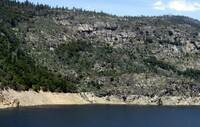- England
- Scotland
- France
- Holland
- Germany
- Italy
- Spain
- Portugal
- USA
- China
- Japan
- India
- Iran
- Advice
- Gardens
- England
- Scotland
- France
- Holland
- Germany
- Italy
- Spain
- Portugal
- USA
- China
- Japan
- India
- Iran
- Advice
- Garden Tours
Book: Landscape Planning and Environmental Impact Design: from EIA to EID
Chapter: Chapter 5 Reservoir planning and design
The so-called 'drawdown problem' yields an interesting perspective on reservoir planning. In 1912, John Muir wrote that each summer Hetch Hetchy 'would be gradually drained exposing the slimy sides of the basin and the shallower parts of the bottom' (Muir 1912: 261). His criticism of manï¾made lakes has been echoed by all authors who have written on the landscape of reservoirs (Tandy 1975: 144). When first asked to address the question of reservoir planning, the present writer embarked on a photographic tour to collect illustrations of this terrible problem. It proved impossible to find any atrocities and after a time it became apparent that the 'drawdown problem' is primarily a consequence of conceiving reservoirs as natural lakes. If the viewer is prepared to appreciate the types of scenery which are found along river estuaries [Fig 5.6] and sea coasts then the problem is greatly diminished. It looks worst on clay substrates and when topsoil and vegetation are flooded to a depth which precludes the growth of aquatic and semi-aquatic plants. Waterï¾saturated topsoil does not look or smell pleasant. Research has been carried out on the establishment of vegetation on reservoir margins (Gill & Bradshaw 1971). The next stage should be to investigate physical solutions to the problem: the performance of artificial sand and gravel beaches, the removal of topsoil to hasten beach formation, the construction of offshore berms to limit wave erosion, the use of quarrying to create steep reservoir margins, and the construction of artificial islands to prevent long views of mud banks. In South East Asia is normal to lease the drawdown land for intensive agriculture (Stefan 1981: 115). At Ashtabula Lake, in America, some $3m has been spent on stone for bank protection because the demand for water recreation has increased sharply since it was impounded in the early 1950s (Stefan 1981: 18). The solution to the 'drawdown problem', as to most aspects of reservoir planning, depends on the location and character of the site.
